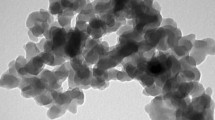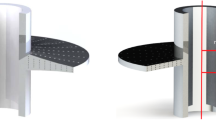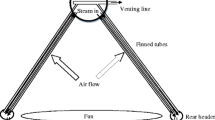Abstract
A fin-and-tube heat exchanger was modeled based on Volume Averaging Theory (VAT) in such a way that the details of the original structure was replaced by their averaged counterparts, so that the VAT based governing equations can be efficiently solved for a wide range of parameters. To complete the VAT based model, proper closure is needed, which is related to a local friction factor and a heat transfer coefficient of a Representative Elementary Volume (REV). The terms in the closure expressions are complex and sometimes relating experimental data to the closure terms is difficult. In this work we use CFD to evaluate the rigorously derived closure terms over one of the selected REVs. The objective is to show how heat exchangers can be modeled as a porous media and how CFD can be used in place of a detailed, often formidable, experimental effort to obtain closure for the model.











Similar content being viewed by others
Abbreviations
- A :
-
Area (m2)
- A f :
-
Fin surface area (m2)
- A o :
-
Total surface area (m2)
- A w :
-
Wetted surface (m2)
- A wp :
-
The cross flow projected area (m2)
- c p :
-
Specific heat (J/(kg·K))
- D i :
-
Inner diameter of the tube (m)
- D o :
-
Outer diameter of the tube (m)
- D c :
-
Fin collar outside diameter, D c = D o + 2δ f (m)
- D h :
-
Porous media hydraulic diameter (m)
- d p :
-
Diameter of the spherical particles (m)
- F 1, F 2 :
-
Blending function
- F p :
-
Fin pitch (m)
- f :
-
Friction factor
- h :
-
Heat transfer coefficient (W/(m2·K))
- k :
-
Turbulence kinetic energy per unit mass
- k f :
-
Thermal conductivity of the fluid (W/(m·K))
- k s :
-
Thermal conductivity of the solid (W/(m·K))
- k T :
-
Turbulent heat conductivity (W/(m·K))
- m :
-
\( \sqrt {{{\left( {2h} \right)} \mathord{\left/ {\vphantom {{\left( {2h} \right)} {\left( {\lambda_{f} \delta_{f} } \right)}}} \right. \kern-\nulldelimiterspace} {\left( {\lambda_{f} \delta_{f} } \right)}}} \), parameter
- \( \dot{m} \) :
-
Mass flow rate (kg/s)
- \( \left\langle m \right\rangle \) :
-
Average porosity
- N :
-
The number of tube rows
- Nu :
-
Nusselt number
- P k :
-
Shear production of turbulence
- Pr:
-
Prandtl number
- Pr T :
-
Turbulent Prandtl number
- P t :
-
Transverse tube pitch (m)
- P l :
-
Longitudinal tube pitch (m)
- p :
-
Pressure (Pa)
- \( Re_{{D_{c} }} \) :
-
Reynolds number based on fin collar outside diameter and maximum velocity, \( Re_{{D_{c} }} = {{u_{max} D_{c} } \mathord{\left/ {\vphantom {{u_{max} D_{c} } \nu }} \right. \kern-\nulldelimiterspace} \nu } \)
- \( Re_{{D_{h} }} \) :
-
Reynolds number based on hydraulic diameter and average velocity, \( Re_{{D_{h} }} = {{{{\tilde{\overline{u}}}}D_{h} }}/ \nu \)
- R eq :
-
Equivalent radius for circular fin (m)
- r :
-
Radius of tube, including collar thickness (m)
- S :
-
An invariant measure of the strain rate
- S w :
-
Specific surface of a porous media, \( S_{w} = \partial S_{w} /\Updelta {{\Upomega}} \) (1/m)
- S wp :
-
The cross flow projected area per volume (1/m)
- T :
-
Fluid temperature (K)
- T s :
-
Solid temperature (K)
- u :
-
x direction velocity term (m/s)
- w :
-
z direction velocity term (m/s)
- X L :
-
\( {{\sqrt {\left( {{{P_{t} } \mathord{\left/ {\vphantom {{P_{t} } 2}} \right. \kern-\nulldelimiterspace} 2}} \right)^{2} + P_{l}^{2} } } \mathord{\left/ {\vphantom {{\sqrt {\left( {{{P_{t} } \mathord{\left/ {\vphantom {{P_{t} } 2}} \right. \kern-\nulldelimiterspace} 2}} \right)^{2} + P_{l}^{2} } } 2}} \right. \kern-\nulldelimiterspace} 2} \), geometric parameter (m)
- X M :
-
P t /2, geometric parameter (m)
- α :
-
Turbulence model constant or scale attack angle
- \( \beta ,\beta^{*} \) :
-
Turbulence model constant
- φ 1 :
-
Represent any constant in the original k-ω model (\( \sigma_{k1} , \ldots \))
- φ 2 :
-
Represent any constant in the transformed k-ε model (\( \sigma_{k2} , \ldots \))
- φ :
-
Represent the corresponding constant in the SST model (\( \sigma_{k} , \ldots \))
- δ f :
-
Thickness of a fin (m)
- μ :
-
Viscosity (Pa·s)
- μ T :
-
Turbulent eddy viscosity (Pa·s)
- ν :
-
Kinematic viscosity (m2/s)
- ν T :
-
Turbulent kinematic viscosity (m2/s)
- ρ :
-
Density (kg/m3)
- σ ɛ :
-
k-ε turbulence model constant
- σ k :
-
Turbulence model constant for the k equation
- σ ω :
-
k-ω turbulence model constant
- τ wL :
-
Laminar shear stress (N/m2)
- τ wT :
-
Turbulent shear stress (N/m2)
- ΔΩ:
-
The volume of the REV (m3)
- ω :
-
Specific turbulence dissipation rate
- ~:
-
A value averaged over the representative volume
- –:
-
An average of turbulent values
- ^:
-
Fluctuation of a value
- \( \left\langle f \right\rangle_{f} \) :
-
Means the superficial average of the function f
- f :
-
Fluid phase or fin surface
- in:
-
Air-side inlet
- out:
-
Air-side outlet
- T :
-
Turbulent
- s :
-
Solid phase
- 1:
-
A value in the air side
- 2:
-
A value in the water side
- 0:
-
Evaluated at the wall or surface
- b:
-
Evaluated at the bulk temperature
References
Rich DG (1973) The effect of fin spacing on the heat transfer and friction performance of multirow, smooth plate fin-and-tube heat exchangers. ASHRAE Trans 79:135–145
Rich DG (1975) The effect of the number of tubes rows on heat transfer performance of smooth plate fin-and-tube heat exchangers. ASHRAE Trans 81:307–317
McQuiston FC (1978) Heat mass and momentum transfer data for five plate-fin-tube heat transfer surfaces. ASHRAE Trans Part 1:266–293
McQuiston FC (1978) Correlations of heat mass and momentum transport coefficients for plate-fin-tube heat transfer surfaces with staggered tubes. ASHRAE Trans Part 1:294–308
Wang C–C, Chang Y-J, Hsieh Y-C, Lin Y-T (1996) Sensible heat and friction characteristics of plate fin-and-tube heat exchangers having plane fins. Int J Refrig 19:223–230
Wang C–C, Chi K-Y (2000) Heat transfer and friction characteristics of plain fin-and-tube heat exchangers, part I: new experimental data. Int J Heat Mass Transf 43:2681–2691
Wang C–C, Chi K-Y, Chang C-J (2000) Heat transfer and friction characteristics of plain fin-and-tube heat exchangers, part II: correlation. Int J Heat Mass Transf 43:2693–2700
Tang L-H, Min Z, Xie G-N, Wang Q-W (2009) Fin pattern effects on air-side heat transfer and friction characteristics of fin-and-tube heat exchangers with large number of large-diameter tube rows. Heat Transf Eng 30:171–180
Jang J-Y, Chen L-K (1997) Numerical analysis of heat transfer and fluid flow in a three-dimensional wavy-fin and tube heat exchanger. Int J Heat Mass Transf 40:3981–3990
Tang LH, Zeng M, Wang QW (2009) Experimental and numerical investigation on air-side performance of fin-and-tube heat exchangers with various fin patterns. Exp Therm Fluid Sci 33:818–827
Xie G, Wang Q, Sunden B (2009) Parametric study and multiple correlations on air-side heat transfer and friction characteristics of fin-and-tube heat exchangers with large number of large-diameter tube rows. Appl Therm Eng 29:1–16
Lu C-W, Huang J-M, Nien WC, Wang C–C (2011) A numerical investigation of the geometric effects on the performance of plate finned-tube heat exchanger. Energy Convers Manage 52:1638–1643. doi:10.1016/j.enconman.2010.10.026
Anderson TB, Jackson R (1967) Fluid mechanical description of fluidized beds. Equations of motion. Ind Eng Chem Fundam 6:527–539. doi:10.1021/i160024a007
Gaitonde NY, Middleman S (1967) Flow of viscoelastic fluids through porous media. Ind Eng Chem Fundam 6:145–147. doi:10.1021/i160021a026
Whitaker S (1967) Diffusion and dispersion in porous media. AIChE J 13:420–427
Whitaker S (1972) Forced convection heat transfer correlations for flow in pipes, past flat plates, single cylinders, single spheres, and for flow in packed beds and tube bundles. AIChE J 18:361–371
Travkin V, Catton I (1995) A two-temperature model for turbulent flow and heat transfer in a porous layer. J Fluids Eng 117:181–188
Travkin VS, Catton I (1998) Porous media transport descriptions—non-local, linear and non-linear against effective thermal/fluid properties. Adv Colloid Interface Sci 76–77:389–443
Travkin VS, Catton I (1999) Turbulent flow and heat transfer modeling in a flat channel with regular highly rough walls. Int J Fluid Mech Res 26:159–199
Travkin VS, Catton I (2001) Transport phenomena in heterogeneous media based on volume averaging theory. Adv Heat Transf 34:1–144
Zhou F, Hansen NE, Geb DJ, Catton I (2011) Obtaining closure for fin-and-tube heat exchanger modeling based on volume averaging theory (VAT). J Heat Transf 133:111802
Geb D, Zhou F, Catton I (2012) Internal heat transfer coefficient determination in a packed bed from the transient response due to solid phase induction heating. J Heat Transf 134:042604
Horvat A, Catton I (2003) Numerical technique for modeling conjugate heat transfer in an electronic device heat sink. Int J Heat Mass Transf 46:2155–2168
Horvat A, Catton I (2003) Application of Galerkin method to conjugate heat transfer calculation. Numer Heat Transf Part B Fundam Int J Comput Methodol 44:509–531
Horvat A, Mavko B (2005) Hierarchic modeling of heat transfer processes in heat exchangers. Int J Heat Mass Transf 48:361–371
Horvat A, Mavko B (2005) Calculation of conjugate heat transfer problem with volumetric heat generation using the Galerkin method. Appl Math Model 29:477–495
Vadnjal A (2009) Modeling of a heat sink and high heat flux vapor chamber. PhD Thesis, Aerospace Engineering University of California Los Angeles, Los Angeles, p 209
Zhou F, Hansen NE, Geb DJ, Catton I (2011) Determination of the number of tube rows to obtain closure for volume averaging theory based model of fin-and-tube heat exchangers. J Heat Transf 133:121801
Zhou F, Catton I (2011) Numerical evaluation of flow and heat transfer in plate-pin fin heat sinks with various pin cross-sections. Numer Heat Transf Part A Appl 60:107–128
Menter FR (1994) Two-equation eddy-viscosity turbulence models for engineering applications. AIAA J 32:1598–1605
Menter FR, Kuntz M, Langtry R (2003) Ten years of industrial experience with the SST turbulence model. Turbul Heat Mass Transf 4:625–632
Acknowledgments
The support of a DARPA initiated grant within the MACE program, Grant No. W31P4Q-09-1-0005, is gratefully acknowledged. The views, opinions, and/or findings contained in this article are those of the author and should not be interpreted as representing the official views or policies, either expressed or implied, of the Defense Advanced Research Projects Agency or the Department of Defense.
Author information
Authors and Affiliations
Corresponding author
Rights and permissions
About this article
Cite this article
Zhou, F., Catton, I. Volume Averaging Theory (VAT) based modeling and closure evaluation for fin-and-tube heat exchangers. Heat Mass Transfer 48, 1813–1823 (2012). https://doi.org/10.1007/s00231-012-1025-7
Received:
Accepted:
Published:
Issue Date:
DOI: https://doi.org/10.1007/s00231-012-1025-7




